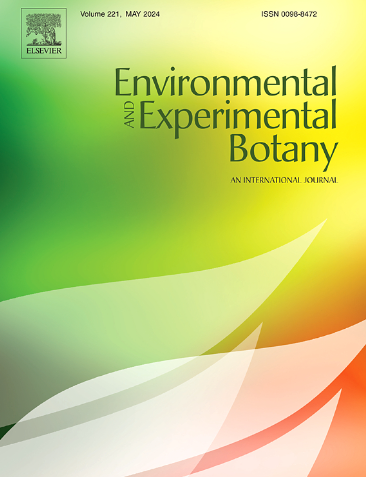Induced post-invasive defenses in the nonhost plant Parthenium hysterophorus L. prevent root cortical colonization by Macrophomina phaseolina and impart resistance to dry root rot
IF 4.7
2区 生物学
Q2 ENVIRONMENTAL SCIENCES
引用次数: 0
Abstract
Dry root rot (DRR) of chickpea is caused by the broad-range necrotrophic fungus Macrophomina phaseolina. Chickpea germplasm does not provide durable resistance to DRR, which is particularly devastating under drought. Even moderately resistant chickpea varieties become susceptible under combined stress. We hypothesized that nonhost resistance (NHR) is durable even under combined stress. Using the blotter paper assay and stereomicroscopic observations, we identified the asterid weed Parthenium hysterophorus as a potential nonhost of M. phaseolina among 82 potential nonhosts. Epidermal necrotic lesions were prevented in P. hysterophorus. In planta fungal load was 0.195 and 0.007 ng/ng total DNA in chickpea and P. hysterophorus, respectively. M. phaseolina could not colonize the P. hysterophorus root while up to 6 cortical cell layers were colonized in chickpea. Further, NHR was durable under combined stress. Dual RNA sequencing revealed that M. phaseolina actively attempted to infect the nonhost and activated specific genes in the xenobiotics degradation pathway. P. hysterophorus also showed an active defense response with1958 and 2294 differentially expressed genes at 2 and 4 DAI, respectively, with 363 upregulated at both time points. Differential expression of cell wall synthesis, phytohormone signaling, and other defense response pathways likely contributes to NHR. Few genes in the phenylpropanoid biosynthesis pathways in P. hysterophorus were also upregulated, possibly because these metabolites are linked to the distinct changes in the fungus during nonhost infection. We therefore conclude that P. hysterophorus exhibits post-invasive NHR to M. phaseolina and that general defense, phytohormone signaling and secondary metabolic pathways contribute to NHR.
非寄主植物Parthenium hysterophorus L.诱导的入侵后防御可以阻止phaseolina在根皮层的定植,并增强对干根腐病的抗性
鹰嘴豆干腐病是一种广域的坏死性真菌。鹰嘴豆种质不能提供持久的抗DRR能力,这在干旱下尤其具有破坏性。即使是中等抗性的鹰嘴豆品种也会在联合胁迫下变得敏感。我们假设即使在联合胁迫下,非宿主抗性(NHR)也是持久的。利用吸墨纸实验和体视显微镜观察,在82株潜在非寄主植物中,我们鉴定出了一株具有潜在非寄主特征的asterid weed Parthenium hysterophorus。表皮坏死性病变在子宫假体中得到预防。在植物中,鹰嘴豆和宫草的总DNA含量分别为0.195和0.007 ng/ng。在鹰嘴豆中,有多达6层的皮层细胞可定植。此外,NHR在综合压力下是持久的。双RNA测序结果显示,菜绿分枝杆菌积极尝试感染非宿主并激活外源降解途径中的特定基因。在第2代和第4代,子宫棘球蚴分别表达了1958个和2294个差异基因,其中363个差异基因在两个时间点均表达上调。细胞壁合成、植物激素信号和其他防御反应途径的差异表达可能导致NHR。子宫假单胞菌苯丙素生物合成途径中的一些基因也被上调,可能是因为这些代谢物与真菌在非宿主感染期间的明显变化有关。因此,我们得出结论,子宫假单胞菌对菜绿分枝杆菌表现出侵袭后的NHR,一般防御、植物激素信号和次生代谢途径参与了NHR。
本文章由计算机程序翻译,如有差异,请以英文原文为准。
求助全文
约1分钟内获得全文
求助全文
来源期刊

Environmental and Experimental Botany
环境科学-环境科学
CiteScore
9.30
自引率
5.30%
发文量
342
审稿时长
26 days
期刊介绍:
Environmental and Experimental Botany (EEB) publishes research papers on the physical, chemical, biological, molecular mechanisms and processes involved in the responses of plants to their environment.
In addition to research papers, the journal includes review articles. Submission is in agreement with the Editors-in-Chief.
The Journal also publishes special issues which are built by invited guest editors and are related to the main themes of EEB.
The areas covered by the Journal include:
(1) Responses of plants to heavy metals and pollutants
(2) Plant/water interactions (salinity, drought, flooding)
(3) Responses of plants to radiations ranging from UV-B to infrared
(4) Plant/atmosphere relations (ozone, CO2 , temperature)
(5) Global change impacts on plant ecophysiology
(6) Biotic interactions involving environmental factors.
 求助内容:
求助内容: 应助结果提醒方式:
应助结果提醒方式:


